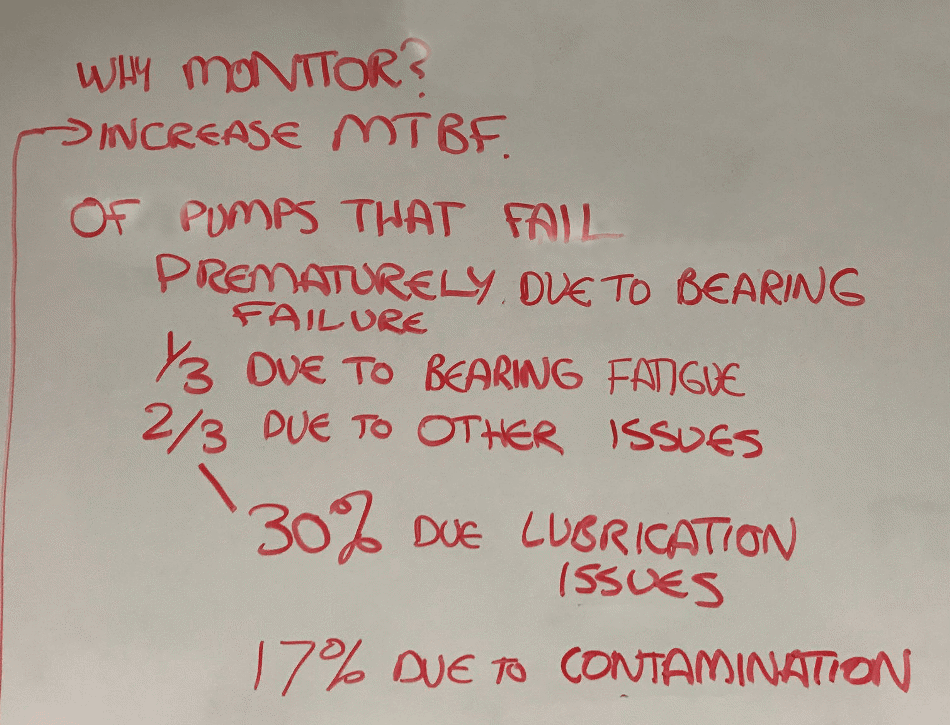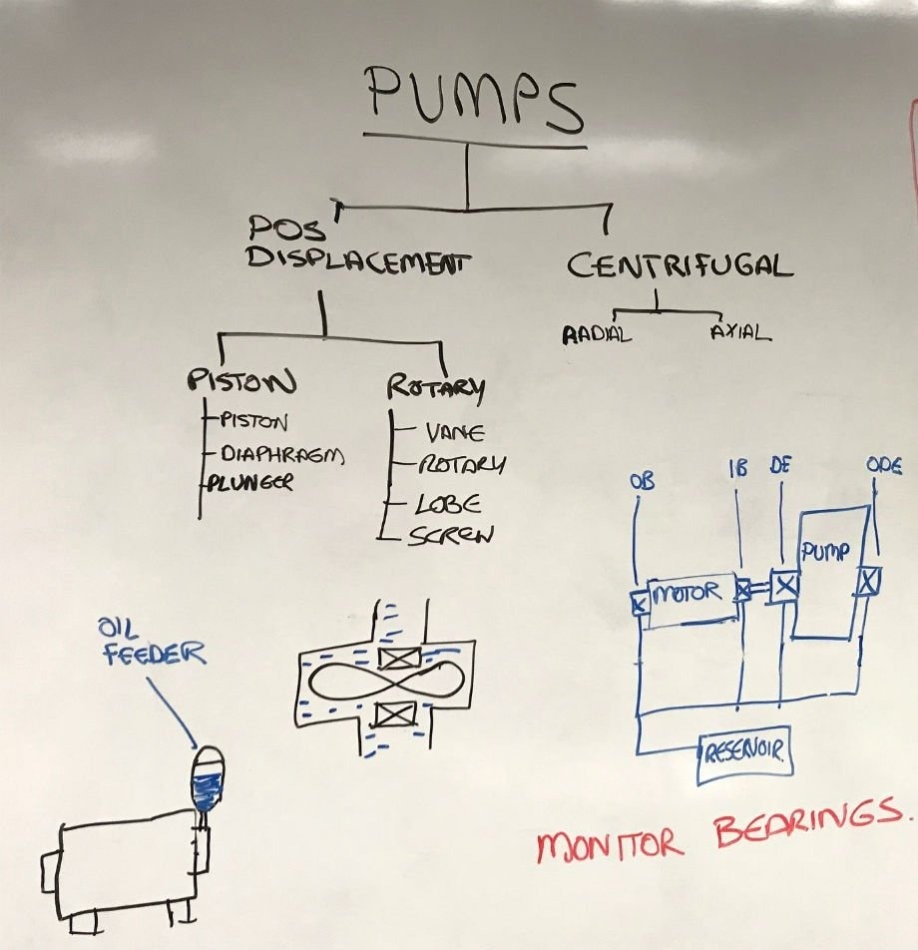Pumps are used in fleet and industrial applications for moving gases and liquids. A majority of the pumps employed in industrial applications are either centrifugal or positive displacement. In both instances, bearings are the component to be lubricated and monitored. Rotary positive displacement pumps have lobes, screws, vanes or gears which are also lubricated - normally by their pumping fluid, be it an oil/air mix or a lubricant.
Ask the Expert: Pump Oil Analysis
Bearing failures are the second major cause of pump repairs, following mechanical seals. Pump maintenance through oil analysis concentrates mainly on the bearings and their service life. A majority of the pump bearings do not attain their theoretical (L10) fatigue life. Two-thirds of all rolling element bearings in service fail prematurely and have to be replaced. Only one-third of the bearings fail because of fatigue spalling (L10 Life). Among the two-thirds that fail prematurely, the breakdown is as follows:
- Premature failing of 30% of bearings occurs due to lubrication issues:
- Degraded lubricant
- Poor or incorrect lubricant
- Lack of lubricant
- 17% of the failure is caused by contamination entering the bearing. This is the most distressing factor as contaminants exist everywhere.
Typical contaminants are:
- Water
- Air
- Particulates
- Cleanup/process chemicals

Monitoring pumps through oil analysis is a conventional method for enhancing the MTBF of the pump.

Kinematic Viscosity
Kinematic viscosity is defined as the resistance of a fluid to flow under gravity. The most significant physical property of lubricant for pumps is viscosity. The viscosities of lubricants differ based on their grade or classification, and also the degree of oxidation and contamination in service. Oil viscosity is predicted to increase over time and use, and viscosity loss is regarded as more serious than an increase. In rotary screw systems, the oil is mixed with lubricant and then separated, hence the viscosity must be measured after the separator or else the gas or air will influence the result. Viscosity is frequently measured immediately after an oil change to confirm the correct oil was added, and also on a periodic basis. New methodologies make it simple to measure kinematic viscosity—solvent-free, low-volume systems are available that integrate ease of use with data logging capability.
Water Contamination
Globally, water is the most common liquid contaminant in pumps and has to be constantly monitored. Excessive water in a system destructs the capability of the lubricant to separate opposing moving parts, allowing serious wear to occur with resulting high frictional heat. Water contamination should not surpass 0.25% for most equipment, but centrifugal pumps used in power plants specify considerably stringent limits, for instance, 500 ppm for boiler feed pump bearings. Various new technologies exist for the detection of contamination of water in lube oils, and on-site results are in exceptional correlation with laboratory methods.
Particle Counting
Particle counting measures the purity of a fluid and is a crucial test for centrifugal pumps in which rolling element bearings or sleeve bearings are being monitored. In positive displacement pumps, it helps in determining the occurrence of wear or ingression on other moving parts apart from bearings. Vane and gear pumps have very strong tolerances and are vulnerable to jamming if the oil is not filtered properly. It is essential to realize the cause when particle counts are higher. More recent methodologies, for instance, LaserNet Fines, not only count particles and report to SAE AS 4059 or ISO 4406 but also offer more information about particle morphology to help the user to realize where the particles are originating from. Particle imaging allows maintenance teams to instantly inspect dirt/sand particles and also the level of ferrous debris that contributes to the count. This level of information allows the development of smarter work orders and concentrating on removing the root cause of the particle.
Total Acid Number
Total acid number is a titration technique intended to signify the relative acidity in a lubricant. Oil changes are regularly indicated when the TAN value attains a fixed level for a given lubricant and application. A sudden increase in TAN signifies an abnormal operating condition (for instance, overheating) that needs investigation.
Elemental Spectroscopy
Elemental spectroscopy is a method for the detection and quantification of elements in used oil as a result of contamination, wear, and additives. The oil sample is energized to make every element emit or absorb a quantifiable amount of energy, which signifies the concentration of elements in the oil. The results reflect the concentration of all dissolved particulates and metals (from additive packages). This test is the backbone for all off-site and on-site oil analysis, as it offers details on machine, wear condition and contamination correctly and rapidly.
For pumps, elemental spectroscopy can be applied to detect bearing wear from non-ferrous roller components.
Infrared Spectroscopy
Infrared spectroscopy is an excellent method for the detection of water, organic contaminants, and oil degradation products in a used oil sample. These are detected by examining the infrared spectrum of the used oil and searching for absorption at particular peaks relative to the presence of several components. The concentration of these components is proportional to the amount of light absorbed at the wavelength of interest.
Oxidation is a measure of the degradation byproducts in the oil. If oxidation becomes serious, the lubricant will corrode critical pump surfaces, as well as deposit lacquer or silt at servo valves. The oxidation is directly proportional to the “oxidation number”.
Wear Debris Analysis/Analytical Ferrography
Wear debris analysis (WDA) explains either an analytical or a patch method which isolates magnetic wear particles from the oil and deposits them on a glass slide called as a ferrogram. Microscopic investigation of the patch or slide allows characterization of the wear mode and possible sources of wear in the machine. This method is called analytical ferrography. It is a good indicator of abnormal non-ferrous and ferrous wear, yet it is typically only performed by skilled analysts.

Recommended oil analysis test packages for pumps

This information has been sourced, reviewed and adapted from materials provided by AMETEK Spectro Scientific.
For more information on this source, please visit AMETEK Spectro Scientific.